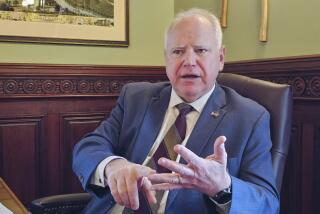U.S. May Finally Be Wising Up on Education
America’s 2.1 million public school teachers have received larger pay raises than any other major segment of the nation’s work force in the past two years and, in general, the schools are getting more money than they have had in many decades.
But the gains so far are not nearly enough to attract the number of new teachers needed to meet the predicted teacher shortage of 1.2 million over the next eight years, end the classroom shortages or make the other kinds of dramatic improvements needed in the educational system.
Teachers, almost all of whom are union members, gained salary increases of 14.4% over the two-year period. That was more than double the average increase won by workers under major collective bargaining agreements and well above the 8% inflation during that period.
Yet, even with their increases, teachers’ salaries still average only $23,572 and start at about $15,000 a year.
In Los Angeles, starting salaries have jumped to $20,655 from less than $13,000 four years ago. But top-level salaries have gone up much less dramatically, and now, even with 10 years of experience and more than enough extra college credits--98--to get a master’s degree, a teacher here can only earn up to $35,384 a year.
It will take more money to achieve the nation’s educational goals. But that alone won’t be enough. The increasingly popular concept of giving workers a greater voice in the corporate decision-making process should be extended to public school teachers, many if not most of whom know at least as much about the educational process as the principals, supervisors and school board members who now make almost all of the major decisions affecting the schools.
It may already be one of those “too little and too late” situations.
Nevertheless, if the encouraging two-year trend of boosting school budgets and teacher salaries continues, if teachers are given a significant role in the decision-making process and if the general interest in improving education is sustained, our children and the entire nation may yet get the educational system that we are capable of providing.
For decades, the National Education Assn. and the AFL-CIO American Federation of Teachers have tried to focus public attention on public education, including everything from teachers’ salaries to smaller classes. Teachers in recent years became more militant, and the once-conservative NEA itself became a militant teachers union, boasting that it was calling more strikes than its smaller rival, the AFL-CIO-affiliated AFT.
Well over 90% of the nation’s teachers are union members, making them the most highly unionized segment of the nation’s work force.
But, while increased teacher militancy may have helped to improve the public schools a bit, public education was often regarded as just another social welfare problem that needed more taxpayers’ money, primarily to help minorities and the poor. Also, more than 65% of all teachers are women, and they faced the same problem that most women must deal with: getting paid as much for work in female-dominated jobs as men get in male-dominated jobs of comparable worth.
President Reagan hasn’t hesitated to cut the share of the federal budget devoted to easing the nation’s social welfare problems, including federal funds for education that have been slashed by about 20%, after adjustment for inflation, since he took office.
Despite all of these negative factors, however, public education seems to have entered a new era.
Now the controversial concept of “comparable worth” is spreading rapidly, despite some legal setbacks and Reagan’s condemnation of it as a “cockamamie idea . . . that would destroy the basis of free enterprise.”
More and more citizens seem to accept the comparable worth idea for teachers, who usually earn less than truck drivers or other workers in male-dominated jobs that require far less training and fewer responsibilities than are required to be a teacher.
And, while Reagan, with congressional approval, has reduced the federal government’s role in education substantially, he likes to talk about its importance. And his skills as an orator have helped to take education out of the “social welfare” category to which it had so long been relegated.
There have been thousands of studies over the years about the need to improve education in the United States, but few seemed to have much impact until the eloquently written “A Nation at Risk: The Imperative for Educational Reform” was issued on April 25, 1983, by a blue-ribbon panel, the National Commission on Excellence in Education.
That report had a greater impact that its predecessors for at least two reasons:
- Its language was often blistering: “If an unfriendly foreign power had attempted to impose on America the mediocre educational performance that exists today, we might well have viewed it as an act of war.” It was the kind of “crisis” language to which Americans most readily respond, especially when coupled with an idea that implies a threat to this country by a foreign power.
- The panel that wrote the report was appointed by Reagan, the most conservative President of modern times, and so it, like Reagan’s own rhetoric, helped pull education out of the “social welfare problem” category and thus made it somewhat easier to deal with.
By reducing the role of the federal government in education, Reagan threw the problem back to the states. Perhaps sensing some political advantages, and because of an increased awareness of the problem, the challenge was taken up by governors like Tennessee’s Lamar Alexander, a Republican, and, after some delay, by California’s GOP Gov. George Deukmejian and others who helped give significant boosts to their states’ education budgets.
The teachers unions intensified their efforts to improve the educational structure, and they attracted powerful new allies in addition to conservative politicians and the liberals who were already on their side.
The added support came from many corporate executives concerned by the competition from increasingly well-educated work forces in such countries as Japan. They concluded that the future of their own companies depends on having a well-educated work force.
Also indirectly helping education is the teacher shortage. The “best and the brightest” high school students have not been going into teaching and generally are still not, despite the recent financial gains, because they can do better in private industry. And the top pay isn’t enough to hold many teachers who take early retirement.
In Los Angeles, for instance, where a shortage of 3,500 teachers is predicted next year, teachers are retiring in near-record numbers. Up to 10,000 of the district’s 30,000 teachers will soon be eligible for retirement.
Wayne Johnson, president of the United Teachers of Los Angeles, says top salaries for teachers ought to be at least double that paid to new teachers.
But the increasing awareness of the growing teacher shortage has created the kind of crisis atmosphere that is helping to bring more money into education.
Albert Shanker, president of the American Federation of Teachers, said the union’s latest survey of teacher salaries “should be regarded as good news for America’s dedicated teaching force.”
“However, even though teacher pay increases outpaced inflation during the past two years, we cannot forget the days of misery during the 1970s, when just the opposite was true and school systems were encountering cutbacks, freezes and double-digit inflation.”
And Mary Hatwood Futrell, president of the National Education Assn., warned that, while salary increases for starting teachers are essential, top-level salaries must also be raised significantly to keep teachers in the profession.
“This autocratic profession we are in must be made more democratic so that teachers are no longer squeezed out of the decision-making process,” she said.
A start has been made in dealing with the crisis in education, but it is only a start. Considering the short attention span that so many of us seem to have when dealing with the nation’s problems, it will take the combined efforts of the business community, unions, educators and political leaders at the national, state and local levels to achieve the goal of a superior public school system.
Bridges to Be Honored
Harry Bridges’ once-radical talk and frequent speeches extolling the virtues of the Soviet Union helped to make him the most persecuted trade union leader in the nation.
But for more than 40 years he fought off his enemies and successfully defeated decades of federal government attempts to send him back to his native Australia for alleged membership in the Communist Party.
And, as founder and president of the International Longshoremen’s and Warehousemen’s Union, he worked within the capitalist system that he said he despised to help make West Coast longshoremen among the best paid workers in the world.
On February 9, the 84-year-old Bridges, now retired, will be honored at a testimonial dinner at the Los Angeles Hilton in what is being called by its sponsors “a celebration of a life, a movement, an epoch.” The sponsors include Los Angeles Mayor Tom Bradley, San Francisco Mayor Dianne Feinstein and more than 150 other political, labor, business and education leaders.
Bridges was ultimately vindicated by the U.S. Supreme Court after innumerable investigations by local, state and federal government agencies and congressional committees that accused him of everything from criminal conspiracy to perjury based on his denial of the allegation that, at one time in the 1930s, he had joined the Communist Party.
One critical court decision held that the record in Bridges’ case “will stand forever as a monument to man’s intolerance of man. Seldom if ever in the history of this nation has there been such a concentrated and relentless crusade to deport an individual because he dared to exercise the freedom that belongs to him as a human being and that is guaranteed to him by the Constitution.”
His success in fighting his political foes may, indeed, stand as a monument, both to him and the judicial system that finally ended those years of persecution, and undoubtedly that will be celebrated at his testimonial next month.
But he will surely be feted also for the success of the waterfront revolution that he helped lead.
That revolution first made longshore work a well-paid, often envied job. Then it changed the entire system of shipping around the world, dramatically increasing productivity through union contracts that encouraged “containerization,” which substituted giant cranes, containers and computers for the muscular dockworkers who once did the backbreaking work of loading and unloading cargo one item at a time.
Bridges’ role in labor history is secure, but it is fitting that it be celebrated now in his presence.
More to Read
Sign up for Essential California
The most important California stories and recommendations in your inbox every morning.
You may occasionally receive promotional content from the Los Angeles Times.










